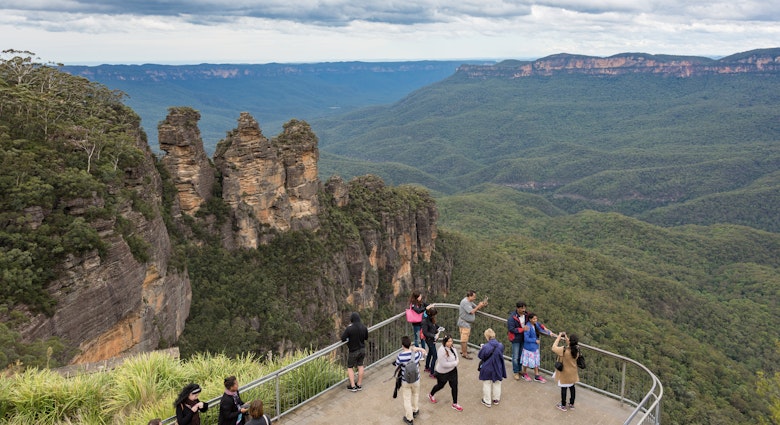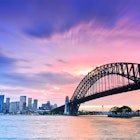
Australia is on the road to recovery
Sponsored by
- placement: logo
- path: articles/header-badge-logo
- possible size: [1, 1],
- targeting:
{ "url": "australia-recovery", "destination": "Australia", "continent": "Australia-&-Pacific", "country": "Australia" }
Mar 31, 2021 • 6 min read

Animals such as the Tasmanian Devil are recovering from the 2020 bushfires at Healesville Sanctuary © Zoos Victoria
Despite the setbacks of the 2020 bushfires and pandemic, Australia is still home to a wealth of exceptional experiences, typified by its world class food and unique wildlife.
It has been a difficult eighteen months for tourism in Australia. First, devastating bushfires ravaged the south-eastern States, in the summer of 2019-20, then came the coronavirus pandemic that forced the world to take a breather from international travel. But, Australia hasn’t wasted any time perfecting what it has to offer visitors.
- placement: fullWidth
- path: articles/in-content-top
- possible size: [970, 250], [970, 90], [728, 90], [300, 250], [320, 50], [1, 1],
- targeting:
{ "url": "australia-recovery", "destination": "Australia", "continent": "Australia-&-Pacific", "country": "Australia" }
Australia’s big-ticket attractions – world-class beaches, the Great Barrier Reef, the Red Centre, Kakadu, sophisticated Sydney – are well-known and just as appealing as ever. But “people are increasingly going for more intimate experiences,” says Joost Bakker, the restaurateur behind the innovative Greenhouse restaurant and Future Food System, and one of Australia’s leading sustainability advocates.
“Australia is unique in what it can offer and is going to be at the forefront of future travel trends with its low population density, lots of wilderness, and lots of places to get away. That’s what the rest of the world is craving.”
At the heart of the country’s fresh pitch to travellers lies two enduring Australian elements: extraordinary food and unique wildlife.

Melbourne Food & Wine Festival
Melbourne has few peers when it comes to culinary experiences. Pat Nourse, creative director of the Melbourne Food and Wine Festival, says for a growing city of less than five million people, “Melbourne really does compare favourably with London and New York.”
The 2020 version of the festival was supposed to have been held in March last year, but as the pandemic struck, organizers made the difficult decision to cancel just six days before it was due to begin. A year later, the timing couldn’t be better: the reimagined 2021 festival launched in March 2021 for a domestic audience, just as the world began to re-emerge from a year of lockdowns, isolation, and uncertainty.
“Restaurants here are not something that sit on top of our food scene. They’re a flowering of it,” says Nourse over a morning of musubi and coffee at 279 Victoria Street, just up the road from Melbourne’s iconic Queen Victoria Market . The site is an essential pillar of the city’s remarkable culinary offering and where many festival events will take place.
“Melbourne’s restaurants have grown out of the fact that people here care about eating – they want good food in their lives the same way that they want good sport and good art. It’s part of living well.”
- placement: fullWidth
- path: articles/in-content-middle
- possible size: [970, 250], [970, 90], [728, 90], [300, 250], [320, 50], [1, 1],
- targeting:
{ "url": "australia-recovery", "destination": "Australia", "continent": "Australia-&-Pacific", "country": "Australia" }
Making up for lost time and built around the idea of ‘one year, three festivals’, the 2021 festival will begin in March, return midwinter and crescendo in regional Victoria in the spring.
After a year in which Melbourne endured much stricter lockdowns than anywhere else in Australia, the revamped festival is perhaps the surest sign yet that Melbourne is back to its best.

Healesville Sanctuary
The bushfires that ravaged much of southeastern Australia in late 2019 and early 2020 had a catastrophic impact upon Australia’s wildlife. Since then, Healesville Sanctuary, just outside Melbourne, has been helping to write a powerful story of recovery.
Healesville Sanctuary has always been among the best places to see Australian wildlife (including koalas, kangaroos, emus, wombats, and echidnas) in large, leafy enclosures. Its record on sustainability is also second to none: in 2014, Healesville became the first carbon-neutral zoo in the world, it has nearly eliminated single-use plastics from the zoo’s grounds, and it will soon achieve its goal of sending zero waste to landfills. Renewable energy provides 100 percent of the zoo’s power needs.
During (and immediately after) the bushfires, zoo staff travelled to fire-ravaged areas of the country to set up triage centres for treating badly burnt animals, and its state-of-the-art veterinary hospital provided refuge for badly injured koalas.
But it also had a longer-term goal.
“Some years ago, Zoos Victoria decided that we were not going to let any more Victorian vertebrate terrestrial species go extinct on our watch,” says Monika Zabinskas, Coordinator of Healesville Sanctuary’s Threatened Mammals program.
Through scientific research, captive breeding programs, and reintroductions to the wild, the eastern-barred bandicoot, Tasmanian devil, great Alpine skink, mountain pygmy possum, corroboree tree frogs, and brush-tailed rock wallaby are all recovering. Others – Leadbeater’s possums, Victoria’s state animal (just 40 survive in the wild), orange-bellied parrots (50), and helmeted honeyeaters (barely 200) – remain on the brink, just one bad fire day away from falling extinct.
- placement: native
- path: articles/in-content-native
- possible size: [f, l],
- targeting:
{ "url": "australia-recovery", "destination": "Australia", "continent": "Australia-&-Pacific", "country": "Australia" }
It’s because of Healesville Sanctuary they’re still around. Best of all, this is the only place in the world you can see them all.

Wine & Wildlife
It’s not just in Victoria you can experience the wonder and quiet resilience of Australia’s wineries and wildlife attractions. Queensland and the Northern Territory rank among the finest wildlife-watching destinations on the planet, while Tasmania, New South Wales, South Australia, and Western Australia offer both world-class national parks filled with unique wildlife and award-winning wine-producing regions.
South Australia offers visitors some of Australia’s most accessible and highly respected wine regions in the Southern Hemisphere. Almost everywhere you go, you’ll find cellar doors vying for your attention. Succumb to temptation in McLaren Vale, Clare Valley, the Barossa Valley, Coonawarra, and the Adelaide Hills – only a few of the many found in the state. In each you can take winery tours, indulge in unique experiences, and sample the menus of world-renowned chefs. Check out Africola in Adelaide, Fino in Seppeltsfield or d’Arry’s Verandah in d’Arenberg for the perfect complement to the perfect vintage.
Not far away, the wildlife on Kangaroo Island is making a remarkable recovery from the bushfires, and it remains a fascinating destination for animal lovers. Seals, birds, dolphins, echidnas and (of course) kangaroos call this laid-back island home. Check them out with the Bushfire Recovery Wildlife Journey from Exceptional Kangaroo Island and learn how you can help with efforts to monitor endangered species.
Another option for those looking to combine culinary and wildlife experiences lies on South Australia’s Eyre Peninsula. Sample some of Australia’s best oysters in Coffin Bay on a tour with Oyster Farm Tours or Pure Coffin Bay Oysters, then skip across to Port Lincoln to swim with sea lions or cage-dive with great white sharks at Adventure Bay Charters.
Western Australia’s attractions are also primed and ready for your return. In the state’s southwest, the Margaret River region is an exceptional wine and gourmet food destination, one where boutique wineries, craft breweries, artisan cheesemakers, and farmers’ markets are all part of this town brimming with the energy of travellers from all walks of life. Watch whales with Naturaliste Charters off the southern coast, surf some of Australia’s wildest breaks near Cape Naturaliste, and explore little-known national parks, from Stirling Range National Park in the south to Kalbarri National Park a long day’s drive north of Perth.
Wherever you choose to go, many things haven’t changed about visiting Australia. But the country sure can’t wait to welcome you back.
You might also like
Australian adventures that give back to the land and people
Learning from Australia’s Indigenous storytellers
Sponsored by Tourism Australia
As a travel entertainment and inspirational media outlet, we sometimes incorporate brand sponsors into our efforts. This activity is clearly labeled across our platforms.
This story was crafted collaboratively between Tourism Australia and Lonely Planet. Both parties provided research and curated content to produce this story. We disclose when information isn’t ours.
With sponsored content, both Lonely Planet and our brand partners have specific responsibilities:
Brand partner
Determines the concept, provides briefing, research material, and may provide feedback.
Lonely Planet
We provide expertise, firsthand insights, and verify with third-party sources when needed.
- placement: fullWidth
- path: articles/bottom
- possible size: [970, 250], [970, 90], [728, 90], [300, 250], [320, 50], [1, 1],
- targeting:
{ "url": "australia-recovery", "destination": "Australia", "continent": "Australia-&-Pacific", "country": "Australia" }
Explore related stories

Beaches
These 5 day trips from Sydney will show you the splendors of New South WalesNov 22, 2024 • 7 min read


 Festivals & Events10 of the world's best places to celebrate New Year’s Eve
Festivals & Events10 of the world's best places to celebrate New Year’s EveNov 13, 2024 • 7 min read


 Solo Travel20 expert solo travel tips for women from the Lonely Planet team
Solo Travel20 expert solo travel tips for women from the Lonely Planet teamOct 31, 2024 • 11 min read



